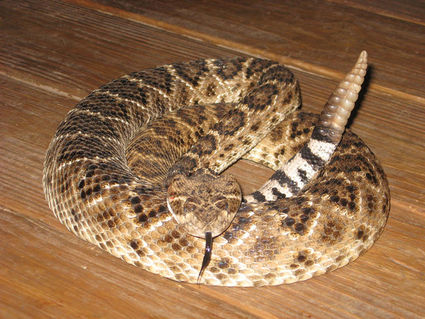Higher temperatures bring snakes out
The warmth that comes with spring brigns increased sightings of Rattlesnakes in Kern County.
"Although snakes generally come out when it is 78-82 degrees to hunt and mate, I am already seeing snakes out as temperatures are reaching 66 degrees," snake hunter Elliot Grimshaw said.
Sightings of road-kill snakes have been reported to Grimshaw in California City and rancher Dory Kline, of Kline's Harem Arabians found a 3-½ foot, 10-rattled rattlesnake under his house just before Easter.
"I have a neighbor here in Cummings Valley, Tehachapi who has already eliminated three rattlesnakes this season as well," Kline said.
Mojave Green Rattlesnakes have been seen since Feb. 22 on Holt Road, in Mojave, according to Pete Cowen of Covert Surveillance.
In addition, "We've already had a number of rattlesnake sightings out at the Soledad Mountain mine-site beginning at the end of February. We have begun awareness training for all of our employees," Denise Talvitie, human relations at the Golden Queen Mining Company LLC said.
"Rattlesnakes are not out to hurt humans. They will, on the other hand, protect themselves," Grimshaw noted.
Although there is a myth about young rattlesnakes having more venom then their adult sized parents, it is simply not true.
"You need to understand that rattlesnakes are opportunistic feeders, which means they will eat what they will find if they are hungry and a food source is available. So if you approach a rattlesnake and they feel threatened or are hungry they will strike.
"Baby rattlers, often times, over inject or release more venom than is needed to subdue prey. Which is why many people believe them to be 'more venomous,'" Grimshaw explained. "But it is just not true, they just haven't learned exactly how much venom it takes to bring down prey."
It is important to remember that when you approach a rattlesnake you are merely a big prey that they want to have the opportunity to protect themselves from or, if they are hungry, eat.
"And, as snakes age and take more prey down, they learn how much venom it takes to take down a multitude of sizes of prey," Grimshaw added.
So, it is not the size of a snake that determines how dangerous they are to humans.
"Furthermore, it saddens me that many people think that all rattlesnakes need to be killed. This is just not true. Rattlesnakes are here to help eradicate rodents [rats and mice]," Grimshaw reminded.
There is another problem, many people within Kern County are so afraid of snakes, of rattlesnakes especially, that Grimshaw is seeing a good many non-rattlers killed on the road, too.
"If you don't want rattlesnakes in and around your property, introduce or allow California King snakes into your environment, as they kill and eat rattlesnakes naturally. And stop just running over snakes, because many of you are running over the snakes that protect you from rattlesnakes," Grimshaw said.
"I have already met a Kern County man who was trying to show some kids how to 'handle' a rattlesnake when he was bitten in the arm. The man is alive, but is now permanently disabled due to the unknown behavior patterns of rattlesnakes," the snake hunter said cautiously.
Grimshaw explained that it has taken years for him to learn the behavior patterns of snakes and if you are untrained, either leave them alone or call a professional to remove them from your location.
"I would hate to see you lose life or limb because your actions backfire on you," Grimshaw said. "But, if you do get struck by a rattlesnake, I hope you have already invested in a venom extractor kit. You can find them at Big 5 Sporting Goods," Grimshaw added.
If you have a rattlesnake on your property give Elliott Grimshaw, the snake hunter, a call at (310) 774-7501.





